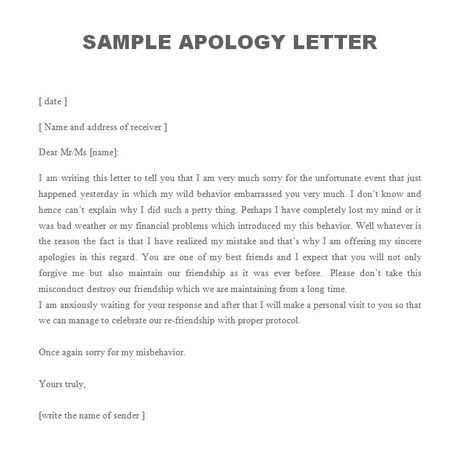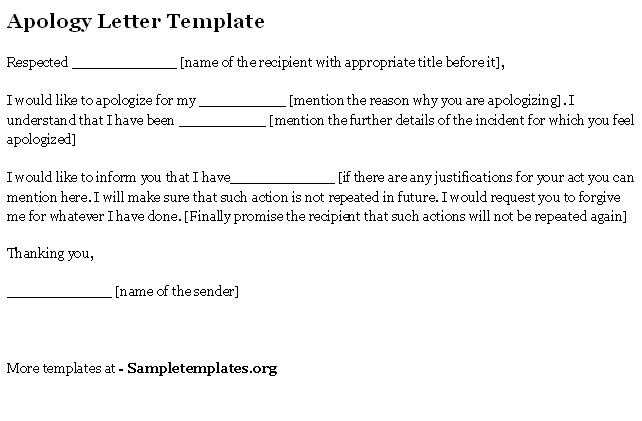Student Apology Letter Template for Various Situations

In any educational setting, it is often necessary to express regret for past actions. Whether due to missed deadlines, misunderstandings, or unintentional mistakes, offering a thoughtful and well-constructed message can help repair relationships and restore trust. A well-crafted expression of remorse is a key component of personal accountability.
Crafting the right message requires more than just stating regret; it involves clearly acknowledging the issue, taking responsibility, and offering steps toward resolution. A sincere approach can not only mend a situation but also demonstrate maturity and respect for others. It’s essential to understand the structure of such a communication, as it can make a significant difference in the outcome.
While expressing regret can be a delicate matter, having a clear structure to follow makes the process easier. Knowing what to include and how to present your feelings ensures that the message is both genuine and effective. In the following sections, we will explore the key elements of a thoughtful apology and how to approach this important task with confidence.
Understanding the Core Components
When it comes to expressing regret, it’s crucial to construct your message thoughtfully. This form of communication requires careful attention to both the tone and content. A clear, sincere message can go a long way in showing accountability and restoring trust. The key to an effective response is making sure it is both personal and genuine while covering essential aspects like responsibility and the impact of the situation.
Choosing the Right Structure
Begin by acknowledging the issue directly and clearly. It’s important to specify what went wrong without making excuses or shifting blame. Taking responsibility is a vital part of the process, as it shows maturity and respect for the other party. Follow this with an expression of regret, ensuring that your remorse is clear and heartfelt. Lastly, suggest steps that will be taken to prevent a recurrence, demonstrating your commitment to improving the situation.
Making the Message Personal
Personalizing the message is key to making it more meaningful. Reflecting on the specific circumstances and addressing the individual involved adds sincerity. It’s important to focus on how the situation has affected both parties, not just on the need to resolve it. Tailoring the message in this way can help convey a deeper sense of care and responsibility.
Recognizing the Importance of Apologies
Expressing regret is a fundamental part of maintaining healthy relationships, especially when misunderstandings or mistakes occur. A sincere acknowledgment of wrongdoings is essential in demonstrating respect for others and showing personal growth. It fosters trust and opens the door for reconciliation, allowing individuals to move forward and strengthen their connection.
The Role of Accountability
Taking ownership of a situation plays a pivotal role in mending any rift. It’s important to fully understand the impact of one’s actions and address it without deflecting responsibility. By acknowledging fault, an individual not only makes amends but also promotes a deeper understanding between parties, paving the way for healing.
Building Trust Through Honest Communication
Clear and genuine communication is the cornerstone of rebuilding trust. When someone admits their mistakes in a straightforward manner, it speaks to their integrity and willingness to learn from the situation. This honesty is often what allows relationships to grow stronger, as it shows maturity and respect for the other person’s feelings.
Selecting the Appropriate Tone

The tone of a message plays a crucial role in how it is received by the reader. It sets the foundation for the overall perception of the communication and can determine whether it leads to understanding or further conflict. When expressing regret, it’s important to find the right balance between sincerity and professionalism, while ensuring the message doesn’t come across as overly formal or too casual.
Key Factors to Consider
- Audience: Consider who you are addressing. A message to a teacher or authority figure may require a more formal tone, while a message to a peer could be less formal but still respectful.
- Emotion: The tone should reflect the level of remorse. If the situation is serious, ensure that the tone conveys genuine regret, but avoid being overly dramatic.
- Purpose: Keep the goal in mind. If the objective is to repair a relationship, make sure your tone is focused on reconciliation rather than just explaining or excusing actions.
Striking the Right Balance
Avoid sounding too apologetic, as this can diminish the strength of the message and might not convey the necessary confidence. At the same time, be sure not to sound indifferent or dismissive. A respectful, humble tone is ideal for conveying both accountability and a commitment to improvement. Use language that is direct yet kind, and always focus on the desired outcome: a resolution that benefits both parties involved.
Organizing Your Apology Clearly
Clear communication is essential when conveying regret. A well-organized message ensures that your points are understood without confusion and demonstrates your commitment to addressing the situation. The structure of your message can impact how your intentions are received, so it is important to arrange your thoughts logically and coherently.
Key Components of a Clear Message
| Step | Purpose |
|---|---|
| Introduction | Start by briefly stating the purpose of the message. Acknowledge the situation without over-explaining. |
| Admission of Responsibility | Clearly accept accountability for the mistake. Avoid justifications or excuses. |
| Expression of Regret | Communicate genuine remorse, showing empathy for how the situation affected the other party. |
| Commitment to Improvement | Offer a plan or steps you will take to prevent the issue from happening again. |
| Conclusion | Finish by expressing appreciation for the recipient’s understanding and offering to discuss the matter further if needed. |
Maintaining Coherence
Ensure that each section flows logically into the next. Use concise sentences and avoid unnecessary details that may distract from your main message. This will help maintain focus and prevent any potential misunderstandings. By following a clear structure, your communication will come across as respectful and well-considered, making it more likely to achieve the desired outcome.
Effective Phrases for a Genuine Apology
Using the right words is essential when expressing regret. The phrases you choose can convey sincerity and understanding, helping to repair any damage caused. It’s important to communicate your feelings clearly while showing respect for the other person’s emotions. Effective expressions create a meaningful dialogue and make your message resonate more deeply.
Here are some examples of phrases that can help convey genuine remorse:
- “I deeply regret my actions and the impact they had on you.”
- “I understand how my behavior must have made you feel, and I am truly sorry.”
- “Please accept my heartfelt apologies for my mistake.”
- “I recognize the harm I caused, and I want to make things right.”
- “I take full responsibility for what happened and will do my best to prevent it in the future.”
- “I truly appreciate your understanding and patience as I work to improve.”
These phrases help express genuine regret and show a willingness to make amends. The key is to use language that feels personal and authentic, avoiding overly formal or insincere statements. By choosing the right words, you can create a positive and constructive tone for the conversation.
Best Time to Send Your Letter
Choosing the right moment to communicate your regrets is just as important as the message itself. Timing plays a significant role in how the recipient will perceive your intentions and can affect the outcome of the situation. Sending your message too soon or too late might result in it not being well received, so it’s crucial to consider the circumstances carefully before reaching out.
When Emotions Have Settled
It’s often best to wait until both parties have had some time to process the situation. If emotions are running high, your message may not be received as intended. Giving space allows both you and the recipient to reflect and approach the situation with a clearer perspective, increasing the chances of a positive outcome.
After Taking Responsibility
Make sure that you’ve taken the time to truly understand the impact of your actions before sending the message. Rushing to communicate without fully grasping the situation can make your message seem insincere. Waiting until you are certain about your accountability and have a plan for making amends will help reinforce the authenticity of your communication.
Letter Examples to Guide You
Having a clear structure and tone is essential when crafting a message of regret. Real-life examples can help you understand how to express yourself effectively while maintaining sincerity. Below are a few sample texts that can serve as a foundation for creating your own message.
Example 1: A Simple and Direct Approach
This format is suitable when you want to be straightforward and respectful, without overcomplicating the message.
- “I would like to express my regret for my actions and the impact they had. I understand how my behavior may have caused you distress.”
- “Please know that I am committed to making changes moving forward and appreciate your patience.”
Example 2: A More Personal and Thoughtful Approach
If you wish to convey deeper reflection, a more personalized message can be more fitting.
- “I deeply regret my actions and the hurt they caused. I have spent time reflecting on my behavior and realize how it affected you and our relationship.”
- “I genuinely appreciate the understanding you have shown and am taking steps to ensure this situation doesn’t happen again.”
These examples provide different tones and structures, helping you adapt to various situations. Make sure to personalize your message, keeping it aligned with your own feelings and the relationship you share with the recipient.